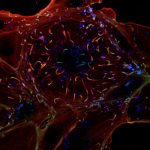I am interested in molecular mechanisms involved in membrane biology of human cells. Biological membranes are fascinating structures and their complex interplay with a steadily increasing number of proteins build the foundation of organellar and cellular integrity. Properties of membranes are strongly influenced by proteins and virtually all processes including transport over membranes, membrane shape and transport of membrane compartments are regulated by the dynamic and tightly regulated interplay of membranes and proteins.
One question that raised my interest since I was a student is how cells can coordinate transport of material between organelles with great precision at incredible high speeds. One transport process is particularly fascinating because it involves the formation of a novel organelle from scratch. This process is called autophagy (self-eating) and delivers cytoplasmic material to lysosomes for degradation. Autophagic cargo includes damaged or superfluous organelle, protein aggregates, multienzyme complexes, ribosomes and intracellular pathogens. This large diversity of cargo is also the reason why autophagy is essential to maintain cellular homeostasis. Dysfunctions of autophagy lead to the onset of many human diseases and a better understanding of molecular principles will enable us to develop new potent drugs to treat these diseases.
In our lab, we aim to reconstitute the formation of autopahgosomes form purified proteins on modle membranes. This is a very powerful approach to reveal principle activities and functions of proteins and membranes. As a trained structural biologist, I love to work with purified proteins and to solve their secrets by structural, biophysical and biochemical tools. The functions that we reveal from our in vitro work inform cell-biological experiments to reveal aspects of regulation, dynamics and functions in context of the cellular environment. Therefor, we apply cutting edge imaging methods including fluorescence lifetime and high resolution imaging, as well as electron microscopy, correlative light-electron microscopy and cryo-EM tomography. We collaborate with the Fluorescence Imaging, EM and NanoImaging facilities on campus to reach our goals.


